Large Epipremnum aureums on central and south Florida trees
My plant collection includes a few Epipremnum aureum plants (AKA: Pothos or Devil's Ivy). I was not compelled enough to get a Golden or Marble Queen until I saw their large mature forms growing outdoors in tropical settings. I was amazed when I first saw them. At first I though they were variegated Monstera Deliciosas. I have several questions on the very large outdoor Epipremnum aureums in central and south Florida I recently saw:
1) Does it matter which cultivar when it comes to growing 12-24 inch leaves? It seems some are Epipremnum aureum 'Golden' and some are Epipremnum aureum 'Marble Queen'. The latter I am sure of. The others I saw and photographed were hard to tell. One of the reasons it was hard to distinguish - aside from distance was because some leaves had yellowish variegation and other leaves had more of a vanilla variegation. Both colors appeared to be on the same vine.
2) What factor or factors cause the outdoor plants to get the large leaves? Is it height above ground? Is it a higher amount of aerial roots on the tree? Are the aerial roots gathering additional nutrients? Is it something else? I've seen a lot of indoor ones on 2-4 ft dry sticks that had their largest leaves only 5-6 inches long. Some I estimated to be over 10 yrs old. I have a better idea now what they do, but why? I just got my first Epipremnum aureum 'Golden' and have attached its vines to grow on a rough-hewn board. While the weather is warm I'm going to place it 4ft above the ground in dappled sunlight to emulate the environment I've seen the large-leaved plants thriving in. I’ll mist it when I can too. That plant is small though so I doubt I'll see much soon.
3) All of the Epipremnum aureums above 6 ft that I got a close enough look at had their new growth ripped up or shredded by something. I'll post enlargements of that if my first posted photo batch doesn't show it well. I was sure Iguanas were close to some and the damage was like damage on leaves that I've seen Iguanas eat. They pull at the leaves and eat mostly just what rips off. Is this happening from Iguanas?
4) It was difficult for me to tell if some of the larger leaves had natural splits (pinnatifid) or were split by wind. The ones I was pretty sure were split by wind were only a block from the beach. But the wind-split leaves also had leaves right above them that I was quite sure had natural splits. The plants in locations with less sun and wind had some completely green leaves with no splits. Most of those were lower on the trees they grew on. Are these common characteristics?
5) If a cutting is taken from a segment with 12-24 inch leaves and placed in a 6 inch pot indoors, will it revert to the 4 inch house plant-sized leaves or keep the large leaves? I read in another post here that it would revert. So would an aerial root factor be needed?
a. If the stem of a 40 foot plant is cut just above the ground where it is small (3/16" to 1/4"), will the plant still grow or will it die?
6) Some of these in FL were in full sun for 1/4, 1/2, 3/4, or all day and most were near water in moist soil. I have often read they don't prefer full sun or wet soil...but that was for indoor ones. Do different environmental preferences apply for the large outdoor Epipremnum aureums?
The next 4 photos were taken at the SW corner of E Las Olas Blvd and Seabreeze Blvd in Ft Lauderdale:

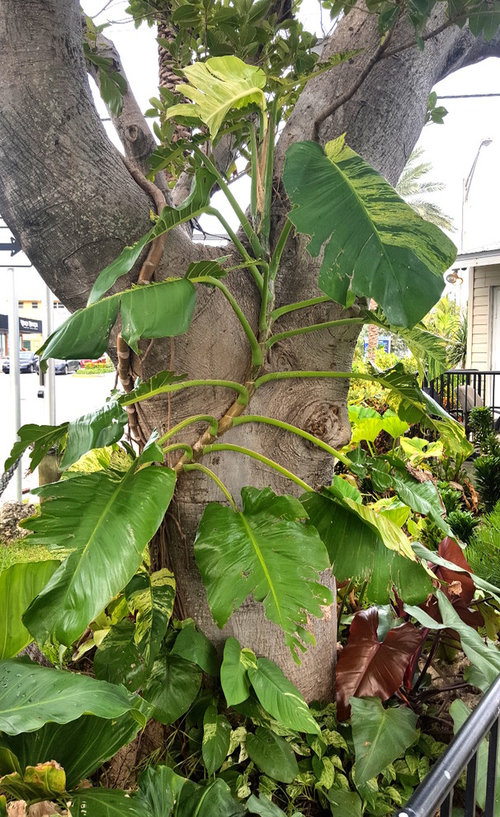
Here's a closeup of the suspected Iguana damage in the above photo:
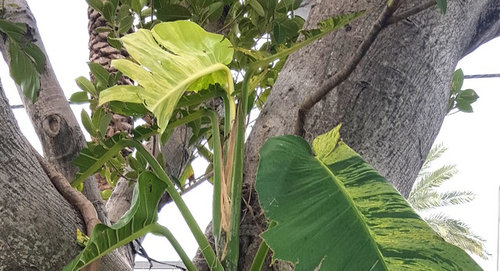
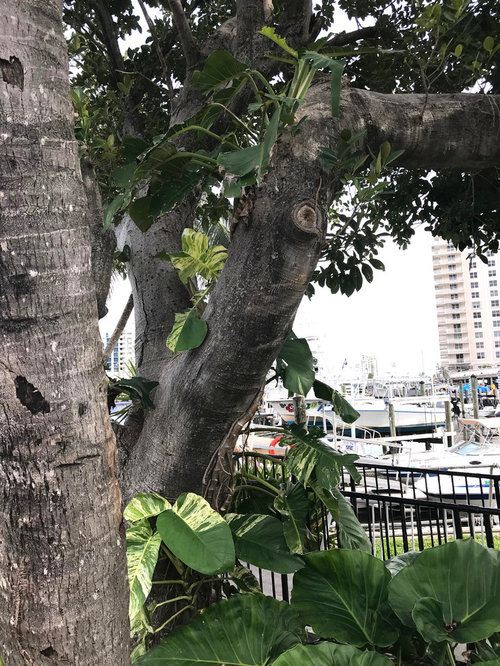
Comments (21)
jay
Original Author5 years agolast modified: 5 years ago...continuation of original post...I had some difficulty adding to and editing my large post so I'm finishing it up as responses and this is 1 of 2 responses...
In the 2nd photo in my original post above, the large leaves on the tree and the small leaves on the ground at the bottom are probably the same plant. I looked at the vine tangles closely and they looked like they were directly connected. I couldn't add that comment to my original post: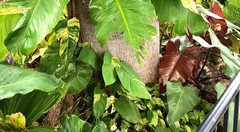
This 1 photo might show Goldens unless the yellow color is from damage. They are on a Strangling Fig(?) tree that was recently cut to a smaller size. The vines appear to have been cut back too in places and may have grown to their current size when shaded but now they are in full sun. This is at a residence on the east side of Ocean Dr in Ft Lauderdale: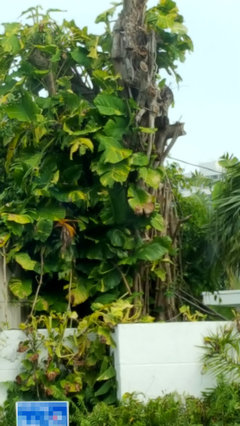
These 2 photos were taken off of New River in Ft Lauderdale. The vines are in 1/2 day full sun and are on trees and shrubbery:
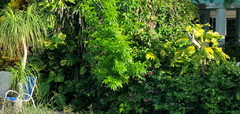
jay
Original Author5 years agolast modified: 5 years ago...continuation of original post...I had some difficulty adding to and editing my large post so I'm finishing it up as responses and this is 2 of 2 responses...
These 8 photos are at a so-called Isle that I visited on a New River dinner cruise in Ft Lauderdale. I could spend all day on that Isle and I will go back. It was beautiful. The largest leaves on all but the below plant were 18-22 inches long excluding petioles (leaf stems).
This plant is just over 6 ft tall and might be a Golden. The larger leaves start at about 3 ft: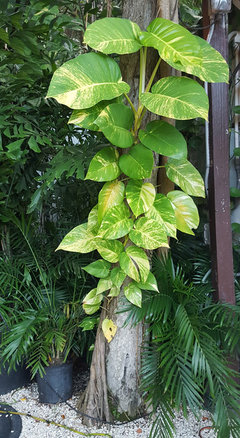
This is another view of the above plant which includes a cut in half version so you can look closer at it. You can see where the vine starts like a houseplant gets larger:
This one became mostly separated somehow but it's still connected with at least 1 aerial root. It seems to be growing well: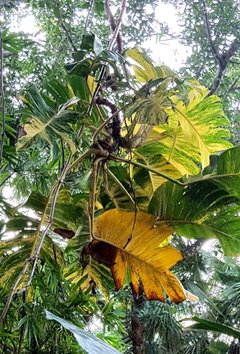

Close-up of the above photo showing suspected Iguana feasting damage on the top shoots. The vine widths at this point are over 2" wide. At the base the vines were only 3/16 - 1/4" wide:
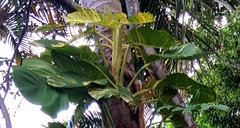
I haven't yet figured out what plant or tree the bunch of roots on the left side of the fan come from. The tree the Epipremnum aureums are on is a palm: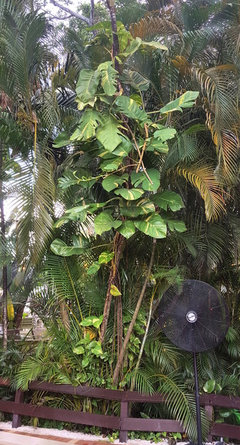
Here's a closeup from the above photo that shows 2 severed vines. The plants don't seem to be affected by these possible upstream cuts. However, the vine on the top right might have a downstream cut:
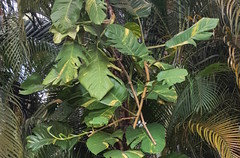
Here are 2 more close-ups that show more detail of the roots:

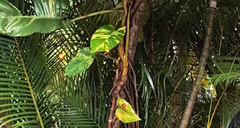
This one has some yellowing - maybe from the Tiki torches that are next to it: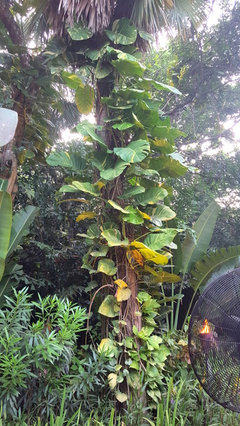
Here's a closeup of the center leaves in the above photo because landscape-oriented photos show more detail than portrait-oriented ones here:

Lastly but slightly OT, this photo I took right at the beach edge in Ft Lauderdale. It's a Green Iguana on a Coconut Palm. It wouldn't let me get close to it. I do like these non-natives and had one as a pet before. I also saw an older male with an orange body and a white head but I couldn't get a photo of it in time. There are too many of them destroying desirable greenery and leaving disease-spreading droppings in public areas though. Except for Green Anoles and Gopher Tortoises, all of the 8 wild terrestrial reptiles I saw on my FL visit were invasive species. The Green Anole is not having an easy time now from increasing invasives competition:
Related Professionals
Glen Ellyn Landscape Architects & Landscape Designers · Prairie Ridge Landscape Architects & Landscape Designers · Medford Landscape Contractors · Melrose Landscape Contractors · Pomona Landscape Contractors · Rancho Santa Margarita Landscape Contractors · Ansonia Landscape Contractors · Windham Landscape Architects & Landscape Designers · Aloha Landscape Contractors · Lancaster Landscape Contractors · Mobile General Contractors · Rolling Hills Estates General Contractors · View Park-Windsor Hills General Contractors · Wheaton General Contractors · Cypress Siding & Exteriorspetrushka (7b)
5 years agolast modified: 5 years agoyou've asked a lot of questions that are addressed in this very long thread
in brief:
1. the vine has to be growing up attached to support to start growing much larger leaves. the quality of light outdoors in so FL is unattainable indoors even under lights - so, no you cannot grow such large leaves indoors. but you can manage Larger leaves then normal. the vine reverts to small leaves very fast if it's hanging down.
aerial roots are just for attaching to the trunk, however the plant can get some nutrients from them too when debris is lodged high up in trees and it composts and it rains every day and it's very warm and humid, so you get compost tea daily running down the trunk..
so for faster growth you need to give it as much light as you can , give it vertical support - and keep it going UP at ALL times. which has limits indoors as we all know..
temps are best 80-85F and soil moist at all times.
2. the leaves split naturally when they become large. but not indoors - you won't get that unless you have a green house and can grow it to 20-30 feet in full sun...
3. the cutting taken with large leaf will grow a much smaller new leaf if you won't give it the same conditions you found it in. in general even outdoors in FL when you cut the growing old vine it will start with small leaves that will gradually increase again when growing up.
4. yes, they grow in full sun in so FL, with some partial shade from the trees though. and it rains daily in rainy season, soaking the soil to saturation. and even standing water is not unusual. you can grow it outdoors in the largest pot in summer and see how different it'll be from the one that is growing indoors. nothing unusual - most houseplants are tropicals and they grow much bigger and under different conditions outside compared to indoors.
for example , most plants that are said to be shade loving tropicals won't grow well indoors unless they get at least partial sun 4-6 hours a day. plants like philodendrons and calatheas and syngoniums, spathiphyllums, etc...because even shade outside there is much brighter then south facing window in the house.
greenhouse is the best option if you want to get growth approaching the natural growth in habitat. but even then your latitude counts - the further north you are the weaker the sunlight. longer hours won't help that much, you also need very warm and humid conditions. that includes the soil. in the tropics with constant decay and moisture the soil temps do not drop below 90F even at night.
rhizo_1 (North AL) zone 7
5 years agoThe root systems are in the actual soil....that's the single most important factor that allows these plants to achieve their potential in size. I've observed it numerous times; even if plants are grown in greenhouse conditions all year round, they won't produce massive leaves unless those aerial roots escape to the real earth. Then the plants are able to enter their more natural growth habits.
User
5 years agoI don’t see how the non-native iguanas (vegetarians) would be competing with the native, insectivorous anole.
Tiffany, purpleinopp Z8b Opp, AL
5 years agoJay, you might enjoy this discussion: https://www.gardenweb.com/discussions/1476902/vines-mature-vs-juvenile-transformations-epiphitic-behavior#n=152
tropicbreezent
5 years agolast modified: 5 years agoI've found that to produce large leaves the plants seems to need some maturity as well as elevation. Vines at the same height can have different sized leaves, the more mature ones having the larger. They produce two types of roots, the small/short "clinging ones" that go direct from the stem to the support and "grab" tight, and thicker ones that run down tree trunks into the ground. Often when the vine gets very high a shoot with small leaves descends to the ground and then runs to another tree. They always move away from the tree they descended from.
This palm tree is 26 metres to the top. The vine can't get into the crown as the palm sheds fronds and the part of the vine that attaches itself is broken off with the falling frond, or else left dangling in the air. Strong winds will eventually break it off anyway.
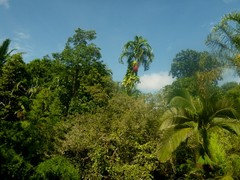
It's sometimes difficult to get a perspective on the size of leaves at that height, until they fall. This one was 73 centimetres along the midrib.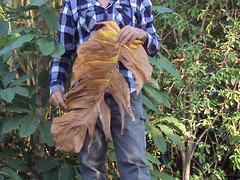
This also gives some perspective, when I was having some trees felled. The full size of the trees was over 30 metres, the vines were up to 25 metres.
jay
Original Author5 years agolast modified: 5 years agopetrushka - thanks for taking the time to respond. I'm digesting it all. Very good reading and I have the thread link. That's my first thread start here and longest post. I may be able to emulate all but the height & soil temp when it is warm out. I'm trying that now and will post a pic. The lowest large leaves I saw in several locations was at 4-4 1/2 feet. There are less than 6 mos of each yr here that don't go below freezing so one would need to be indoors for half of the year. On another topic: I went to the last hr of the Caladium festival and I thought of you when I took a photo of a large bed of Red Flash Caladiums. I plan to post the pics I got there.
rhizo_1 - Hmm. So at least some aerial roots need to reach the ground. In the Las Olas Blvd plants it looked like vines came from the ground and back to the ground. But in that labyrinth it was hard to tell.
jurasico - You're correct. The Iguanas eat some rare greenery that some native wildlife depend on an don't affect Anoles that I know of. The Cuban Anoles and Curlytail lizards eat baby Green and Brown Anole babies. Cuban Anoles also reproduce quicker than Green or Brown.
Tiffany, purpleinopp - I have the link. petrushka posted it too. And I do enjoy reading it.
tropicbreezent - As for the pics: Wow. Wow. And, Wow. What a difference from the ones in hanging pots in large stores here. In my 3rd and final orig post segment above, is that what those roots are - on the left side of the fan? The roots that are: "thicker ones that run down tree trunks into the ground"? I'll post an enlargement.
Ferdinan - you're welcome.
I didn't think to look at the time I was standing next to them, but now after looking at the photo, I'd like to know if the roots dropping to the ground come from an Epipremnum aureum. The palm the plant is on has similar vineless palms next to it and they don't have the roots. Here 2 close-ups of the same photo:
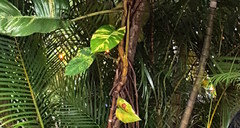
Here is my first attempt to produce larger leaved Epipremnum aureum goldens. I can do this setup for the warm months, and can take it to a place with a sun room for the winters. By chance I got this for $14 (half off) 2 days ago because it appeared to have fallen off a truck and some vines were broken at the bottom. I fixed the stick and repotted it. The plants are exactly 3ft tall with 7 1/2" leaves at the top. Yesterday I built a plexiglass roof for it. I'll mist the totem stick with water that has 20-20-20 fertilizer in it every other week and just water in between (unless misting with fertilizer water is a no-no). I wouldn't have tried this if I didn't see large leaved ones with leaves 4 1/2 feet from the ground: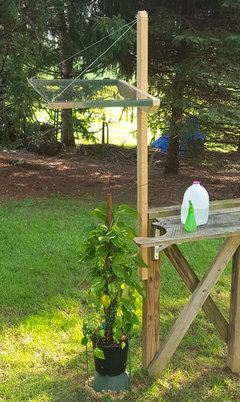
There is a question I still have: What cultivars of Epipremnum aureum are in the FL photos I posted?Matt Barnett
5 years agoMy $.02. The vines produce large leaves by virtue of being able to anchor to and climb a structure. It has nothing at all to do with soil, and little to do with light intensity. You will see monster leaves in full sun, and you will also see the same size leaves growing when it's climbing inside the canopy of a tree that completely shades it, like a banyan. Once it attaches to a tree, you can cut the vine from the soil, and the vine will continue to grow and climb, provided adequate humidity. That doesn't work as well if it is climbing concrete, presumably because it derives some nutrition from tree bark, and not much of anything from concrete.
jay
Original Author5 years agoMatt Barnett - thanks for your input. I located 1 severed vine on my totem and most of its leaves are not yellow. Some are though. It's cut right where it touches the soil and the roots are gone. I suspect this fell off a truck. I've been misting the whole thing mornings and nights with fertilizer water. Plus rain still blows under the plexiglass roof.
Perhaps there is a humidity/moisture benefit to being under a tree that the aerial roots take advantage of. All structures where I live get gray/green algae on them if closely under tree branches or if shaded. This may be more pronounced in FL.
This Epipremnum aureum is on A1A near Harbor Beach Pkwy and I found it with G00gle street view 2016 images. It might be in a pot and it is shaded by a Strangling Fig on the right that is not shown. Its leaves begin to get large, but then when under the dry aluminum eave with no place to grip, the leaves get smaller. Down to about 1/2 the size of leaves 3 feet below the eave. One of the vines on the bottom right came off: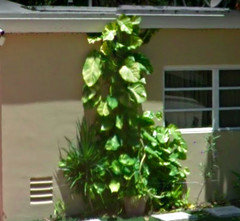
Matt Barnett
5 years agoI would imagine that the grip the plant has is solid on the stucco, and less on the smooth metal soffet where its growing upside down, and it was probably hanging in space trying to attach for a while, causing the reduction in leaf size. I imagine if you looked today you'd see if it was left to grow over the roof, the leaves would have gotten much larger again.
jay
Original Author5 years agolast modified: 5 years agoI found an Epipremnum aureum with a similar growing habit as the one on A1A near Harbor Beach Pkwy in FL in the previous photo above. The largest leaves are near the top, then at the top they get smaller where the vines can't cling anymore. However, this one is indoors in a building and is only about 1/2 of the height though. It has a 12"x9" leaf that is about 3' up from the soil. With the petiole included it is 20" long:
There are several of the plants in pots with sticks that are the same height (~5 1/2' with pots) near large windows but only this one is next to South facing windows and has a leaf this large. Once the vines have reached the end of the sticks the leaves get to only 1/2 of the size as the ones just 14" below them. A leaf on the tip of same vine as the leaf in the photo above is only 6 1/2" long on a 1/4" - 3/8" vine.
The vine is also thicker where this 12" leaf is. The vine is 7/8" wide at that point. At the base of the pot all the vines are about 1/4" wide.
I haven't yet had the growing time to conclusively see what conditions contribute to mature, large leaves on Epipremnum aureums as house plants in a non-tropical location. I did notice some characteristics that all of them (FL and DC region) had once they attached to a surface like a tree, wall, or stick: They had larger, straighter, more angled characteristics than ones that were not attached. Ones that were not attached or were growing downward or horizontally most often had varying degrees of curved vine tips, curved petioles, and curved leaves.
These are my E. aureums that show this. They will be outdoors in dappled sun until the fall:
I created 2 illustrations to show this difference in case the 3-photo set above doesn't show it effectively:
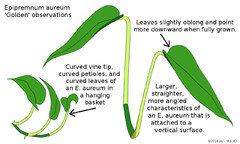
Matt Barnett
5 years agoThat is all correct. The upward-curved vine tip will occur when the vine is growing along the ground, because when it encounters a vertical surface it is positioned to take advantage of it. The same curve will happen when it grows past the top of the vertical surface and is hanging in space because it is still seeking a vertical orientation. If it were to grow straight on the ground and in the air, it would pass the tree or vertical surface instead of attaching to it and climbing it. A straight orientation hanging in the air would put it on a trip back to the ground. This plant is programmed to climb. If it grows on the ground, its leaves are small, and its tip is curved upwards. It grows small leaves to support its growth and focus all of its energy towards elongation. Internodes are long, and it is REACHING to find something to climb. When it encounters a suitable surface and attaches, it has achieved mission number 1. Leaves get larger, and the vine thickens with each new leaf. Internodes get shorter, the tip straightens because it is vertically oriented and attached. If the tip curved now, it would launch itself out into space and defeat mission number two, which is reaching the canopy, where it can get the premium quality light. Right now it is putting all of its energy into growing large leaves, large vines, and large aerial roots to grip its host. It is happy in this position, growing the largest, most robust leaves and vines that are simply not achievable without being attached. It is still reaching (upward), but not with the same desperation. Its needs are being met while it pursues mission number 2.
If you were to pry the tip away from its host, each new leaf will grow smaller, the vine will grow thinner, the internodes will lengthen, and the tip will curve toward a vertical orientation. Now it is again in reaching mode, elongating desperately in search of a new host.
Now I am not a botanist, and i havent read any books on the subject. I learned this by observing its behavior when i encounter it. Maybe someone that has some botanical training can confirm or correct my hypothesis.
jay
Original Author5 years agoWell put. I can see what happens and where it happens but didn't know the reason for the curving. I'm guessing the internodes are the green vine segments I drew. Without even realizing it until now, the internodes are close to the same length in both plant drawings, even though the petioles and leaves are much longer on the attached plant.
tropicbreezent
5 years agoThe curved petioles are to ensure the leaf blades are turned towards maximum light. Also, I've found that the runners that hang down go all the way to the ground. Of course the difference between those being straight or curved is like 'spearing head first' into the ground, or making a 'belly landing' with the tip being able to grow on (without a 'sore head').
Incidentally, found this photo of one of the tree felling contractors with a piece of vine that came down from higher up.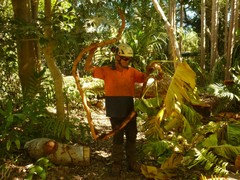
Matt Barnett
5 years agoThat vine looks to be about the size of that guy's forearm. What a monster!
Yes, all that sounds about right. But while the vines grow pretty quickly, i doubt that they grow with enough velocity to actually embed the vine tip into the soil like a javelin. LOL
The petioles always try to orient the leaves to the brightest light. Thats why the leaves always face away from whatever they are climbing. In fact, if they attach to say, the dark side of a tree, the vine will wrap around to the bright side, following the all-important light.
jay
Original Author5 years agolast modified: 5 years agoI'm now on my 3rd EA since the 2018 summer. The first 2 outdoor ones died. Probably from dew and fog that collected on the leaves and vines and dripped on the soil which kept it too moist.
I got the 3rd one in the fall. It was 3 ft tall on a 3 ft tall totem and is kept indoors. It didn't grow much until the last week of Dec. It has grown about 1 foot since then and I've extended the totem to over twice its original height. It's now 6 ft 7 inches above the floor. I'm trying to get large mature leaves to grow. Just today I got my first leaf to get as long as one that was already on the plant when I bought it. That new leaf is 6 3/8 inches long and is pictured below on the right. It is a quarter inch longer than it was yesterday: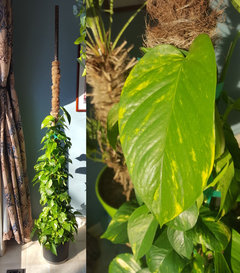
On the bottom left of the photo you can see the edge of a floor vent. The air from the vent causes the leaves on one side of the plant to wave up and down. I'm not sure if it's coincidence or not, but I moved the plant closer to the vent in late Dec and that's when it began growing more quickly. Maybe a constant breeze is a factor of the larger leaf growth. It also gets late afternoon winter sun and a quarter turn every day.
I marked the petiole with a permanent marker so I can keep track of it. I'll try to measure the leaf daily to see how much time it is until it stops growing. Tomorrow I'm expecting it to be a quarter inch longer than it is today. Though small, so far this is my first and only success toward EA large leaf size.jay
Original Author5 years agoUpdate to my 2/4/2019 post above: I have about 3-4 more new leaves that are progressively larger than that one. The latest leaf below is 7 1/8":
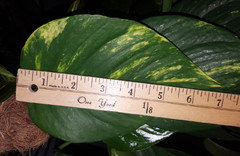
The plant gets full sun from mid afternoon through sunset.
petrushka (7b)
5 years agoyep, that's what i've been saying : put them indoors in good part-sun! mine are in west window and loving it. while they are marked as low light plants that is...and people wonder why are so small leaved or not doing well, etc..




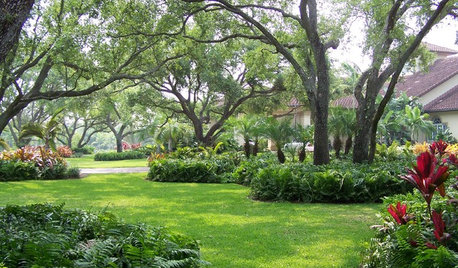
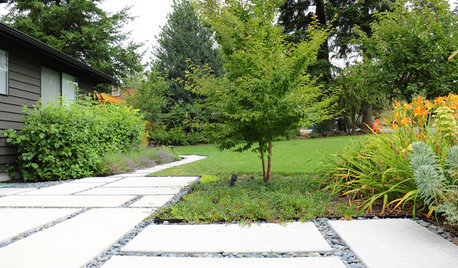
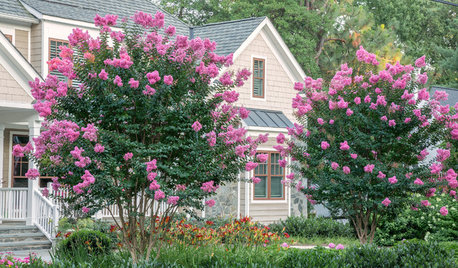
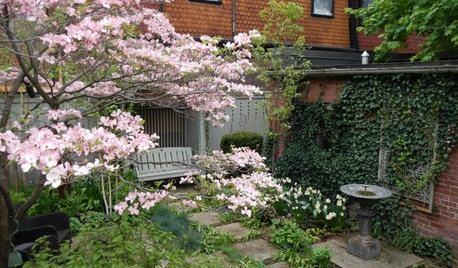








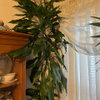
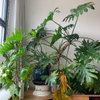
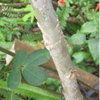

tropicbreezent